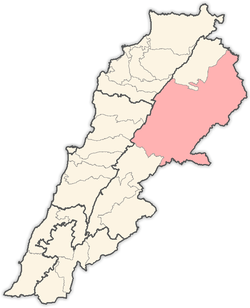Al-Nabi Shayth
| Al-Nabi Shayth Nabi Chit | |
|---|---|
| Village | |
|
Prophet Seth Shrine in Al-Nabi Shayth | |
 Al-Nabi Shayth Location in Lebanon | |
| Coordinates: 33°52′20.4″N 36°06′46.1″E / 33.872333°N 36.112806°ECoordinates: 33°52′20.4″N 36°06′46.1″E / 33.872333°N 36.112806°E | |
| Country |
|
| Governorate | Baalbek-Hermel |
| District | Baalbek |
| Elevation | 4,000 ft (1,220 m) |
Al-Nabi Sheeth (also spelled Nabi Chit; Arabic: النبي شيت) is a village in the Bekaa Valley of Lebanon. "Al-Nabi Sheeth" is an Arabic word, it means "Seth the prophet". The village was called by that name because it is considered to contain the burial site of Seth son of Adam. A mosque was built on the burial site and it contains the grave of Seth inside the mosque. (A rival tradition placed Seth's tomb in the Palestinian village of Bashshit). The village is also the home town of Abbas al-Musawi former Hezbollah leader and influential shia cleric. The village of Al-Nabi Sheeth is predominantly inhabited by people with the surnames Helbawi, Al-Musawi, Hazimeh, & Chokr families being well known.
History
Ibn Jubayr (1145 – 1217 CE) noted: "the two graves of Seth and Noah [..] are in the Bika', and two days' journey from Damascus. One who measured the tomb of Shith (Seth), reported to us that it was 40 fathoms (ba') long, and the tomb of Nuh (Noah) was 30. The tomb of Noah's son lies side by side with that of Noah. There is a building over the tombs, and an endowment for charitable purposes.[1]
Recent Events
During 2006 Lebanon War, Israeli warplanes bombed the house of the former minister Fayez Chokr and killed his father and another house where 7 civilians were killed. The IDF never gave any reason for why the houses had been targeted.[2]
During the Syrian civil war three rockets from Syria hit this town on 13 March, 2014.[3]
See also
References
Bibliography
- HRW (2007). Why They Died: Civilian Casualties in Lebanon During the 2006 War. Human Rights Watch.
- Strange, le, Guy (1890). Palestine Under the Moslems: A Description of Syria and the Holy Land from A.D. 650 to 1500. London: Committee of the Palestine Exploration Fund.
External links
- Nabi Chit, Localiban
